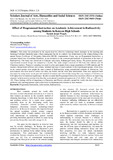| dc.contributor.author | Wangila, Joseph M. | |
| dc.date.accessioned | 2022-05-09T09:24:01Z | |
| dc.date.available | 2022-05-09T09:24:01Z | |
| dc.date.issued | 2016 | |
| dc.identifier.citation | Sch. J. Arts Humanit. Soc. Sci. 2016; 4(12):1522-1528 ISSN 2347-9493 (Print) (An International Publisher for Academic and Scientific Resources) | en_US |
| dc.identifier.issn | 2347-5374 | |
| dc.identifier.uri | https://www.semanticscholar.org/paper/Effect-of-Programmed-Instruction-on-Academic-in-in-Wangila/8c58ff5345984be6f7932c40ef31cb67b7463f54 | |
| dc.identifier.uri | http://hdl.handle.net/123456789/5776 | |
| dc.description.abstract | This study was prompted by the urgent need for effective technology-based strategies in the teaching and learning of abstract chemistry topics whose inadequacy has led to students‟ low achievement in the subject during in the annual Kenya Certificate of Secondary Education (KCSE) examinations. Focus was on Programmed Instruction, a computer-based way of teaching Chemistry, as an alternative to the conventional methods of instruction in the topic of Radioactivity. The study was carried out in Likuyani sub-county, Kakamega County, Kenya. The pretest posttest quasiexperimental research design was adopted as a model. The study sample consisted of 466 form four students and 16 Chemistry teachers. Purposive sampling was used to select participants from a target population of 2,000 students and 56 teachers. Instructional software was created, validated and used to teach students in the experimental groups, while those in the control groups were taught the same content of Radioactivity using conventional methods of instruction. Two achievement tests were used to collect raw data, one before and the other after intervention. Data were analyzed both descriptively (using mean, mean gain and standard deviation) and inferentially (using One-way Analysis of Variance) at 0.05 alpha level of statistical significance. Results revealed that Programmed Instruction was more effective in improving students‟ achievement in radioactivity than the conventional instructional approaches [F (5, 460) = 34.4, p < .001 at α = .05]. These findings will be of importance to Chemistry and Physics educators around the world, who have hitherto had problems with teaching abstract topics effectively for maximum achievement by their students | en_US |
| dc.language.iso | en | en_US |
| dc.publisher | Scholars Academic and Scientific Publishers (SAS Publishers) | en_US |
| dc.subject | Programmed Instruction, Achievement, Radioactivity. | en_US |
| dc.title | Effect of Programmed Instruction on Academic Achievement in Radioactivity among Students in Kenyan High Schools | en_US |
| dc.type | Article | en_US |

